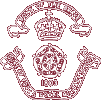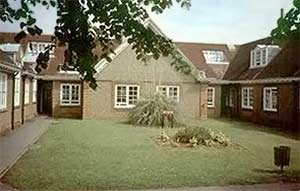


 |
 |
|
 |
||
| Navigation links at the bottom of this page | ||
| What's in a Company Name? | ||
In conformance to the designation of companies, squadrons, batteries and troops in the regular Army by their alphabetical labels, companies in the RMA and renamed Duke of York's School followed suit. From 1803 on, boys and girls were in one or more of the alphabetical companies: A company (or A Coy), B, C, D etc. In the beginning, there were ten companies: A through J, reduced considerably in the 1840s when the authorities began training army schoolmaster sergeants. Some time after the end of the First World War, companies were renamed 'houses' after famous (or infamous depending on one's point of view) generals. And so, today the houses are known as Alenbrooke, Marlborough, Wolfe, Clive, Wellington, Wolseley, Roberts, Kitchener and Haig respectively. When exactly did the renaming take place and to what effect? This question was put to Dan Kirwan (1923-1928), who testified: |
||
| Regarding your query as to when companies became houses, here is my best recollection. It happened in 1927 and, I believe, just before the summer holidays. I was the last B7 and the first Wolfe, which is, I suppose, my one claim to fame. I think it was before the holidays because that year I was transferred from Wolfe to Wellington, at the request of C.S.M. Prescott of Wellington I believe. I don't know that for a fact but C.S.M. Prescott was in charge of the Signaling unit and I was head signaler and had crossed flags on the sleeve of my dress uniform. I know I was in Wellington for a year as Prescott promoted me to L/Cpl, then to Cpl. I was Wn33 and Wn48 and, of course, it meant I got another tuppence a month for my corporal's stripes. This is my best recollection. It is a long time ago. | ||
Traditions die hard. The Dukies of pre-WWII were as conservative as their fathers, for they stuck to the A-Coy, B-Coy, C-Coy labels that had been in use since the first boys and girls entered the old RMA in 1803. Even as late as 1939, the renamed houses were known as companies and commonly referred to by their alpha designations. In January 1939, I joined Kitchener as K51, but, although K51 identified me as 'present' when on roll call, on parade or standing by my bed, I was a member of G Company, not Kitchener House. |
||
 |
||
| Kitchener House, known as G Coy until as late as 1939 | ||
| The outbreak of the Second World War changed all that. The chain of alpha designations from one generation to the next was broken. Evacuated first to Cheltenham, then to Saunton Sands in North Devon in 1941, the alpha description fell into disuse. By the time the school returned to its Dover premises, companies were known by their house names only.
On the evidence of Brian Marley (also K51) of Melbourne, Australia, the one remnant of the descriptive alpha convention was 'Sergeant-major Fry was our CSM at Kitchener. His nickname was "G-Co Fry", but that was the ONLY mention of Alpha in my time at school.' With the not-too-soon re-admission of girls, it might be worth considering renaming the houses they occupy after famous women soldiers of the Army. Surgeon-General James Barry, for example. Barry served as a surgeon in the 19th Century, masquerading as a man for her entire service. Such was her brilliance as a surgeon in South Africa and in the Maritimes Command, Canada, that she rose to become Surgeon-General of the British Army. Her masquerade was discovered only when, as she had willed, her cadaver was donated to medical science. It was also discovered that she had once given birth. Christine Davies, a trooper in Lumley's Cavalry wounded in the Battle of Blenheim (1704) would be another candidate role figure for a renamed house. Davies, mother of three children in Ireland, left her children in the care of her family and enlisted in her husband's cavalry squadron to be with her husband. Wounded on the field of Blenheim, her sex was discovered by the attending surgeons. (Her sex not her gender, which was properly confined to its function of describing nouns until the spear-chucking feminist movement took hold of it.) Yet again, there is Hannah Snell, famed for being the only woman who, at the intervention of the Duke of Cumberland, became a Chelsea Pensioner. Hannah, like Christine Davies before her, enlisted to be with her lover. With the help of her fellow infantrymen, she concealed her sex and fought in the ranks at the Battle of Pondicherry (1761) where she was wounded in the groin by a one-inch lead ball. She refused the attention of the surgeon (wise Hannah). Instead, she removed the ball herself and cauterized the wound with her bayonet heated in the glowing embers of a fire. Brave and courageous women who have served with the colours there are in abundance. It is a thought to consider a name change as once companies were changed to houses and named after generals.At the time of writing, Dan Kirwan of Totowa, NJ, who lives with his daughter Patricia, is the longest-living but one Dukie. |
||
| ||||||||||
|
© A. W. Cockerill 2011 Site Map Contact me | ||||||||||